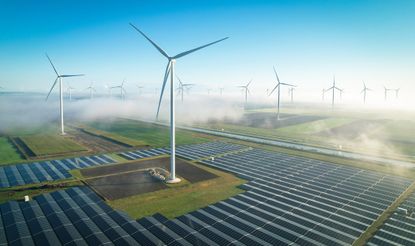The demand for oil is slowing and green energy is taking over
The IEA forecasts oil demand growth to slow sharply in the next few years. The end of the era may be underway.


It looks increasingly likely that the age of oil is on the way out. We’ve been through previous cycles of optimism about other energy sources that didn’t change much: there was plenty of talk about government-backed growth plans involving massive renewables investment after the 2008 crisis, but considerably less action. While there has been increased investment and technological advances that have made renewables cheaper, the world still runs on fossil fuels.
However, it feels different this time. Climate concerns and geopolitical issues have created
a vast incentive for countries such as the US to invest in energy infrastructure (see right). The latest forecasts from the International Energy Agency (IEA), published last week, are clearly in line with that scenario.
Subscribe to MoneyWeek
Subscribe to MoneyWeek today and get your first six magazine issues absolutely FREE

Sign up to Money Morning
Don't miss the latest investment and personal finances news, market analysis, plus money-saving tips with our free twice-daily newsletter
Don't miss the latest investment and personal finances news, market analysis, plus money-saving tips with our free twice-daily newsletter
The IEA thinks that demand growth will slow sharply in the next few years as electric vehicles replace ones that run on fossil fuel. Demand will rise by 2.5 million barrels per day (mb/d) this year, but by 2028 the annual increase will be just 0.4 mb/d. We’ll still use plenty of oil, but it will be petrochemical demand (and to some extent aviation, the hardest transport use to replace) that drives demand growth. Thus the IEA expects total demand of 105.7 mb/d in 2028 and still rising, but combustible fossil-fuel demand to hit a absolute peak of 81.6 mb/d in the same year.
The IEA’s forecasts have had “a questionable history” as Bloomberg puts it – ie, they are very often very wrong. Still, this outlook seems pretty plausible. It’s hard to see what would drive a much faster growth in fossil fuels in a world in which many major economies see the energy transition as a way to drive economic growth. The IEA estimates that more than $2trn is already lined up for clean-energy investment by 2030.
It’s harder to say what this means for oil prices. In the short term, demand doesn’t look especially bullish. Oil demand growth tracks global GDP growth, deflated by about 1.6 percentage points due to efficiency gains, argues Daval Joshi of BCA Research in a recent note. He thinks economic growth and oil forecasts are still too optimistic, and reckons crude could drop to $55.
On the supply side, the IEA is forecasting tight markets next year, on the basis that Chinese demand will rise and Opec will cut demand. That may be unduly bullish: more supplies from sanctioned countries (Iran, Russia and Venezuela) are making their way into markets, and Saudi Arabia’s unilateral cut this month showed that it is struggling to get its Opec peers to join in.
Still, weak prices discourage more investment: US active oil and gas rig have dropped sharply in recent weeks. Ultimately, around $70 may be the sweet spot – generating enough cash without encouraging firms to spend it. The worst scenario for investors would be for Big Oil to ramp up output in the face of the shift the IEA predicts.
Cris Sholto Heaton is an investment analyst and writer who has been contributing to MoneyWeek since 2006 and was managing editor of the magazine between 2016 and 2018. He is especially interested in international investing, believing many investors still focus too much on their home markets and that it pays to take advantage of all the opportunities the world offers. He often writes about Asian equities, international income and global asset allocation.
Cris began his career in financial services consultancy at PwC and Lane Clark & Peacock, before an abrupt change of direction into oil, gas and energy at Petroleum Economist and Platts and subsequently into investment research and writing. In addition to his articles for MoneyWeek, he also works with a number of asset managers, consultancies and financial information providers.
He holds the Chartered Financial Analyst designation and the Investment Management Certificate, as well as degrees in finance and mathematics. He has also studied acting, film-making and photography, and strongly suspects that an awareness of what makes a compelling story is just as important for understanding markets as any amount of qualifications.
-
-
 Top-quality small companies with big scope for long-term growth
Top-quality small companies with big scope for long-term growthA professional investor tells us where he’d put his money. This week: Dr Gareth Blades, analyst at Amati Global Investors, highlights three favourites.
By Nicole García Mérida Published
-
 Starling Bank hikes fixed savings rate to 5.25%
Starling Bank hikes fixed savings rate to 5.25%Starling Bank has hiked the rate on its fixed savings which has shot up from 3.25% to 5.25% - but how does it compare to the rest of the market?
By Vaishali Varu Published

